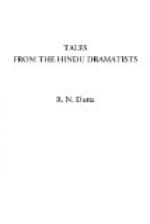Kandarpaketu, a young and valiant prince, son of Chintamani king of Kusumapura, saw in a dream a beautiful maiden of whom he became desperately enamoured. Impressed with the belief, that a person, such as was seen by him in his dream, had a real existence, he resolves to travel in search of her, and departs, attended only by his confidant Makaranda. While reposing under a tree in a forest at the foot of the Vindhya mountains, where they halted, Makaranda overhears two birds conversing, and from their discourse he learns that the princess Vasavadatta, having rejected all the suitors who had been assembled by the king her father for her to make choice of a husband, had seen Kandarpaketu in a dream, in which she had even dreamt his name. Her confidante, Tamalika, sent by her in search of the prince, had arrived at the same forest, and was discovered there by Makaranda. She delivers to the prince a letter from the princess, and conducts him to king’s palace. He obtains from the princess the avowal of her love; and her confidante, Kalavati, reveals to the prince the violence of her passion.
The lovers depart together: but, passing through the forest, he loses her, in the night. After long and unsuccessful search, in the course of which he reaches the shore of the sea, the prince, grown desperate through grief, resolves on death. But at the moment when he was about to cast himself into the sea, he hears a voice from heaven, which promises to him the recovery of his mistress, and indicates the means. After some time, Kandarpaketu finds a marble statue, the precise resemblance of Vasavadatta. It proves to be she; and she quits her marble form and regains animation. She recounts the circumstances under which she was transformed into stone.
Having thus fortunately recovered his beloved princess, the prince proceeds to his city, where they pass many years in uninterrupted happiness.
* * * * *
OPINIONS OF EMINENT EDUCATIONISTS on “THE BOY’S RAMAYANA”
ADOPTED BY THE HINDU SCHOOL CALCUTTA, THE KRISHNAGHUR
COLLEGIATE
SCHOOL, BETHUNE COLLEGIATE SCHOOL, DUPLEX COLLEGIATE
SCHOOL &c.,
Rev. George Bruce M. A. Senior Professor of English Literature, the Scottish churches College, Calcutta and Examiner to the University of Calcutta for the M.A. Examinations in English writes;—
I have looked over Babu Ramanath Dutt’s Ramayana. The English is simple and idiomatic. The story is given in an interesting manner. The style & language are, I think, well-suited for Matriculation students.
THE SCOTTISH CHURCHES COLLEGE.}
4 Cornwallis Square, Calcutta.}
GEORGE BRUCE M. A.
10 Sept.—1910
}
* * * * *
Mr. Jnan Ranjan Banerjee M. A., B. L. Vice-Principal and Professor of English Literature, Philosophy and Law, the Metropolitan Institution, Calcutta; University Lecturer in Philosophy and Examiner to the University of Calcutta writes:—




